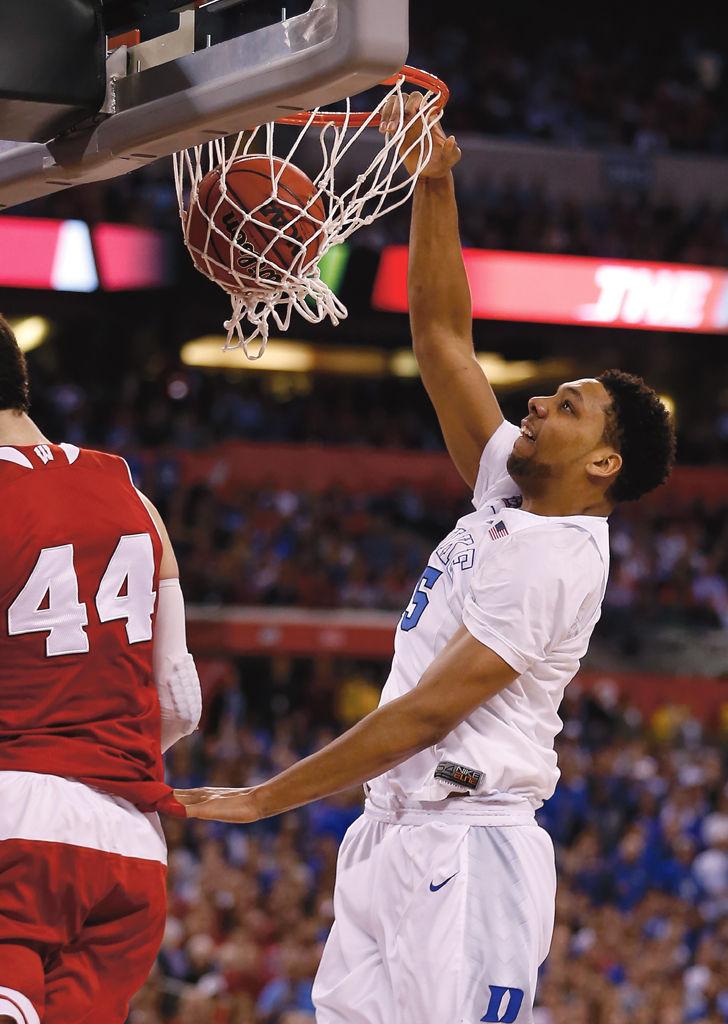Gap year: NBA should let high school players jump to pros


Duke already has a lot of haters, and as the shakiest No. 1 seed, they also had a lot of doubters. All year, Duke was the Jekyll-and-Hyde team of the NCAA, but they were dominant when it counted — the NCAA Tournament.
Now, Duke men’s basketball coach Mike Krzyzewski has the arduous task of keeping the momentum moving despite the inevitable loss of more than half of his younger players to the NBA.
Freshman point guard and Final Four MVP Tyus Jones declared on Wednesday that he will enter the draft, following fellow freshman teammates Justise Winslow and Jahlil Okafor. Add graduating senior Quinn Cook to the list of departures, and Duke is left thin in the returning contributors department, as well as the baby ballers department.
But with the exodus of three star freshmen — one and dones — to the NBA, basketball fans will label Duke as a “freshman factory,” a term casual basketball fans like to throw at schools that lose their top recruits to the NBA after one year.
At Kentucky, John Calipari currently runs the most notorious freshman factory in the game, with three freshmen leaving this year for the draft, including their second-best scorer Karl-Anthony Towns. Others schools, such as Kansas, Arizona and Syracuse, have, to a lesser degree, been criticized by basketball commentators for “renting” players for a year.
“What good is one year of a college education doing these kids?” critics ask.
I’ll admit it’s the right question, but critics are directing it at the wrong people.
A player must be one year removed from high school to be draftedunder the NBA’s draft eligibility rules. Although that player is not obligated to spend that year playing at the college level, it makes sense for aspiring professionals to spend their in-between year competing at the highest level possible.
The critics are correct in saying that this off-year doesn’t do much for players. Education certainly doesn’t seem to be the top priority for athletes in revenue-generating sports, and explotation of high-level recruits is common by universities. Look at Shabazz Napier, a key player in UConn’s NCAA tournament win last year, who said during a press conference that he had some ”hungry nights” where he went to bed starving, lacking a big enough meal plan as part of his scholarship.
Perhaps, then, we need to examine what gives the NBA the right to dictate what basketball players do with a year of their lives.
2005 was the last year in which players were allowed to make the prep-to-pro jump, and the list of players who have been successful straight out of high school is star-studded — LeBron James, Kobe Bryant, Dwight Howard, Amar’e Stoudemire, Kevin Garnett and Tracy McGrady are just a few examples.
Not every player would be successful following this path, but the NBA should not have the power to deny a player the ability to try.
The NFL has a similar rule when dealing with young athletes. To be eligible for the NFL draft, a player must be three years removed from high school. As opposed to the NBA’s restriction, the NFL rule makes sense. There isn’t a high school player alive that’s physically or mentally ready for professional football. It is too fast and too tough a sport for a kid with senior prom still fresh in his mind. This makes the in-between years in college necessary for development. Jonathan Martin, an offensive tackle in the NFL, couldn’t handle the lockeroom environment, and he had three years the NFL requires of a player.
As Joe Walton, a former NFL player and former Robert Morris head coach, said in the Pittsburgh Post-Gazette “I think the rule the way it is, is good. When most kids first get out of high school they are not physically strong enough to give the pros a try.”
But basketball is different. There are no Richie Ingonitos to scare of a young rookie, and you can’t convince me that Duke’s Okafor is any more ready for the NBA now than he was when he graduated from Chicago’s Whitney Young High School last year. The college competiton posed no threat to him. Okafor spent this season trashing post defenses and befuddling help side guards with cross-court passes, and the extra year of making ameatuers look foolish didn’t help him mature
He should have had the opportunity to go pro out of high school.Guys such as Winslow, Arizona’s Stanley Johnson and Kansas’ Cliff Alexander, as well as half of Kentucky’s team, should likewise have had that opportunity.
Jones’ declaration for the NBA draft didn’t surprise anybody. He may not have been as ready for the league last year as some of his classmates, and he may still be unprepared now, but he deserves the right to try.
Recent Posts
SGB introduces new governing code bill and addresses rumors of ICE on campus
At its weekly meeting at Nordy’s Place on Tuesday, Student Government Board introduced an omnibus…
Opinion | School should be in the summer
Although this may be controversial, I believe that from this data, it is evident that…
Weathering the storm: Pittsburgh teams have tackled some of the toughest environments
The end of the year in western Pennsylvania is always marked by two things —…
Notes From an Average Girl // Notes on Book Banning
In this edition of Notes From an Average Girl, senior staff writer Madeline Milchman writes…
To Be Honest // Yup, it is that damn phone
In this edition of To Be Honest, staff writer Evin Verbrugge writes about her phone…
Meaning at the Movies | Portraying Toxic ‘Adolescence’
In this edition of Meaning at the Movies, staff writer Lauren Deaton explores the mini-series…